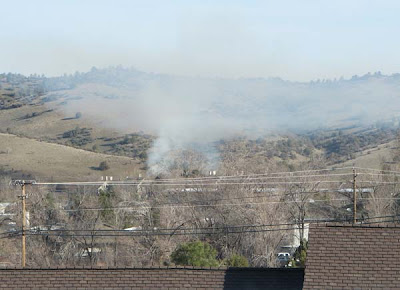
The trouble with photojournalism is that sometimes the pictures force the direction of the story. In this case, literally. Simply put, I can't think of a better entrance to the village of Kirkland than this curve in the road heading back to Prescott from Bagdad and the west country of Yavapai County. So be it. If you decide to visit one of the last cowboy bars in these parts, no doubt you'd be coming from the other direction, down from Skull Valley via Iron Springs Road.

Kirkland is important enough as the site of an elementary school serving territory as far away as Walnut Grove and Wilhoit; student population, 59 kids. In fact, as a sometime property owner in that turf, I can tell you that the school district property taxes are higher than in Prescott! An aside: that distinctive mountain in the background of the picture below is, you guessed it, Kirkland Peak.


The Phoenix-Ash Fork railroad line runs through Kirkland, where some maintenance materials are stored alongside the spur tracks.

A pair of small tufa buildings at the intersection of Iron Springs Road and the highway from SR89 is a distinctive sight in Kirkland. The building to the right served as the post office for many years; I've no idea what might be the story of the building to the left. (To any geologists reading this post, I want you to know that I am aware that
tufa properly refers to a particular type of limestone deposit, whereas the Kirkland area
tufa is actually volcanic tuff. However, locally it is called
tufa. There's even a one-time
tufa mine up the road a piece.)

My guess would be that most of Kirkland's actual resident population lives in the trailer court; there is only a handful of small houses in town (one of which we almost bought before moving to Arizona).

Focal point of the town -- and an important institution for the entire surrounding area -- the Kirkland bar, cafe, and hotel. It's been some years since I was last in the saloon, but at that time, it was definitely a boondocks cowboy bar, with a dance every Saturday night. The for-sale sign is, I am told, a permanent fixture.


When we moved into Wilhoit back in aught81, there was an arena back of the Kirkland Bar. Periodically, it was used by local cowboys who would get together for an afternoon of roping followed by beer. And, about once a month, parents from nearby ranches held a gymkhana for local kids to show off their horsemanship.

No more. The former arena now serves as one more enclosure for livestock and horseflesh (above, below.)


I'm sure it had to have been during the reign of Ronald Reagan that we landed two new post offices out west of Prescott -- in Skull Valley and in Kirkland (above). After all, our congressional district had faithfully elected and re-elected Republican Bob Stump to the House of Representatives forever and a day.

And here's the road heading back into the hills alongside the Skull Valley Wash and the railroad tracks. First stop, Skull Valley and then Prescott. As I said at the beginning, my pictures dictated the beginning and the end points.

 Tomorrow, so I am told, will be dreary with a chance for yet another snow. Reason enough for a yellow post. Already fellow bloggers are posting their own yellows -- predominantly daffodils, but also wild poppies and desert primrose, not to mention early-blooming forsythia.
Tomorrow, so I am told, will be dreary with a chance for yet another snow. Reason enough for a yellow post. Already fellow bloggers are posting their own yellows -- predominantly daffodils, but also wild poppies and desert primrose, not to mention early-blooming forsythia. When I moved, the yellow upholstered furniture was a pleasant surprise, located in a day room in the middle of a long hallway at my new apartment building. Usually, such furniture is covered in rust colors or perhaps plum -- dark and gloomy, but certainly easier to maintain. But I much prefer the yellow; gives my spirits a lift every time I see it.
When I moved, the yellow upholstered furniture was a pleasant surprise, located in a day room in the middle of a long hallway at my new apartment building. Usually, such furniture is covered in rust colors or perhaps plum -- dark and gloomy, but certainly easier to maintain. But I much prefer the yellow; gives my spirits a lift every time I see it.

















































